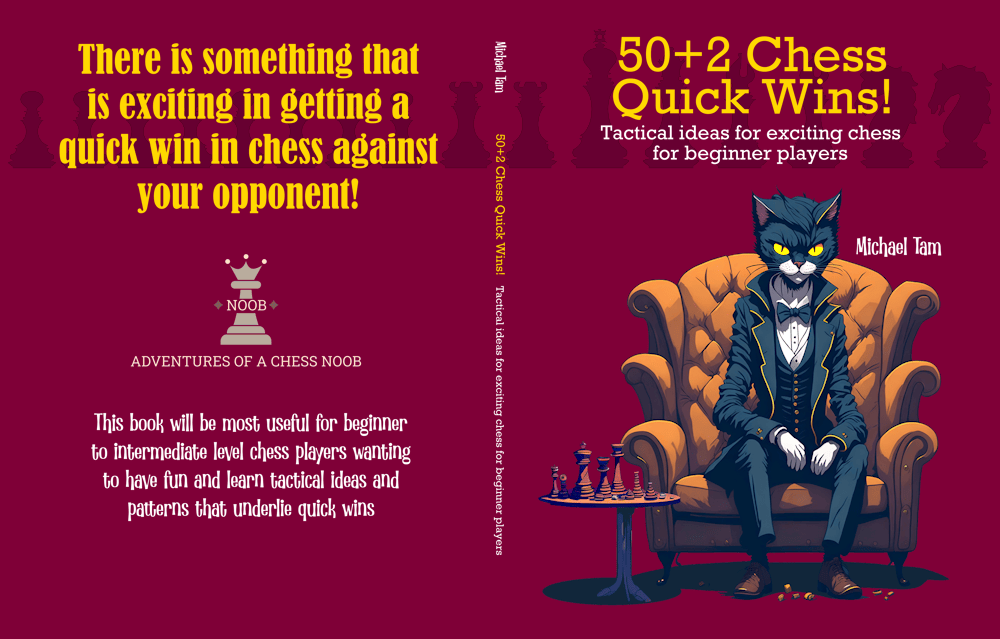
Vienna Gambit | Hunting for Beautiful Checkmates! 😚🤌♟️
#viennagambit #romantic #beautiful #checkmate #legaltrap
One of the great things about the Vienna Gambit is that when it goes well, you not only win, but there is the opportunity to get a beautiful checkmate. To quote myself from my new book (coming VERY SOON! 🤩👍):

![]()
Here are three examples of lovely checkmates in Vienna!
![]()
Game 1: Corralling Black’s king into the field of battle!
https://www.chess.com/analysis/library/4yGz79SL2i
The first game demonstrates a motif that can occur in the Vienna Gambit. Black accepted the (Falkbeer) Vienna Gambit (1. e4 e5 2. Nc3 Nf6 3. f4 exf4?), a mistake, and instantly, we know that we’re in for a good time!
The game progressed as typical in the opening, except that on turn 7, I played a tricky (7. Bc4!?), immediately pressuring Black’s f7-pawn/square, rather than the more standard (and logical) (7. Bxf4), which recaptures a pawn, supports my e5-pawn, and avoids a potential scary-looking problem with a future Qh4+ by Black.
However, I was baiting Black to do this! 🤩 This was practically a second gambit and Black walks right into it. Their tactical logic seems sound: Black first exchanges their bishop for my knight (7… Bxf3), which removes my defender of the h4 square. Then, they follow up with (8… Qh4+), which seems to be a forcing move. I get to play (9. g3!) and Black immediately follows up with (9. fxg3). In the usual lines where this can happen in the Vienna Game, Black will often end up capturing White’s h1-rook with promotion to a new queen. In this specific game, it looks like Black would be able to force a trade of queens and complete the exchange up a point of material.
However, (9… fxg3??) was a blunder – there is checkmate-in-6! This all started with my early (7. Bc4!?). After the bishop-knight exchange (7… Bxf3 8. Qxf3), I had both my bishop and queen looking at f7, which effectively pinned Black’s advanced f4-pawn to their f7-pawn!
On turn 10, I start a line of forced checks with (10. Qxf7+). In the subsequent turns, I force Black’s king off their throne, to walk into the field of battle in front of his own pawns and dragged to the queenside. This is a common tactical motif in the Vienna. Here is our canvas for creating beautiful checkmates! In this game, I force the king to capture my knight on his final turn (15… Kxa4) and I give checkmate with a coordination of my queen and bishop pair (16. Qb3#). Black’s queen, which had attempted a counterattack half a game ago on turn 8 (8… Qh4+?!), gazes forlornly across the entire fourth rank. While she is stuck on the h-file, her king is executed on the a-file!
![]()
Game 2: Légal’s Trap in the Vienna Gambit (Max Lange)
https://www.chess.com/analysis/library/CTy4oHm7k
The second game was a Vienna Gambit in the Max Lange Defense (1. e4 e5 2. Nc3 Nc6 3. f4), to which my opponent declined with (3… d6). Ah ha! In the research for Become a Chess Assassin! I studied a game played by Harry Pillsbury, the US Chess Champion (Pillsbury—Fernandez, 1900, Germany) in a simul exhibition and it demonstrates how the Légal Trap can easily come out of this exact opening (Vienna Game: Max Lange Defense, Vienna Gambit, Declined 3… d6).
As a brief historical aside, Pillsbury was lauded as the new “Morphy” and in an alternate universe, he might have become the World Chess Champion. Halfway into the St. Petersburg 1895-96 tournament, he was a full point ahead of then reigning (second) World Chess Champion Emanuel Lasker, but then bombed out of the second half from severe illness – he was probably suffering from the effects of primary syphilis, an infection he like caught in the weeks prior to the tournament from sex workers in St Petersburg. Had he defeated Lasker in this tournament, it may well have triggered a subsequent match between Pillsbury and Lasker for the World Champion title! Unfortunately, Pillsbury remained in poor health from this point onwards and died only ten years later at the age of 33, from neurosyphilis and stroke. 😔
The ingredients (that are under the opponent’s control) for the Légal Trap to be possible is that Black needs to have their d-pawn on d6, must not have developed their king’s bishop or king’s knight, and have “pinned” White’s f3-knight to the queen with their light square bishop on g4. Most of these steps are quite normal-looking and intuitive moves to have been played in the Max Lange Vienna Gambit.
On turn 5, Black attempts an aggressive attack on my f3 knight by advancing their knight (5… Nd4). I leap my knight forward (6. Nxe5!?), technically a blunder in this position, but it’s a very sneaky “oh no, my queen!” trap! Black could not resist the hanging queen (6… Bxd1??) and the trap closes!
The Légal Trap is one of the most beautiful early checkmates through the combination of three minor pieces: (7. Bxf7+!) and Black’s king is forced to bongcloud (7… e7) as the d- and f7 squares are defended by White’s e5-knight. But then, the second knight leaps into the centre of the board (8. Nd5!#) and somehow, a mating net has been woven. Beautiful!
![]()
Game 3: A Morphy-esque checkmate of Black’s king on White’s back rank!
https://www.chess.com/analysis/library/38NPVqYfnN
The third game was a regular (Falkbeer) Vienna Gambit, but like the second example, declined by d6 (1. e4 e5 2. Nc3 Nf6 3. f4 d6). This is the second-best response by Black to the Vienna Gambit (best is the Main Line with 3… d5), so there is a bit of shuffling and some captures in the opening. As is common in the Vienna Gambit lines, White can sometimes gain a massive development advantage over Black. One of the tactics in the Vienna Gambit is to attack down the f-file, and in this match, it overwhelmed Black very quickly and on turn 16, they’d blundered and had lost their queen.
There were many pedestrian ways to convert this to a win, the simplest of which is to force piece trades into a simple winning endgame. However, just like in game 1, this can be now the canvas for endgame beauty and I’m especially proud of this one which has echoes of some of the deliberately beautiful checkmates constructed by Paul Morphy, the short-lived US chess champion of the 1850s and a Romantic genius on the chess board!
The motif is similar to game 1, to corral Black’s king off their back rank, walking ahead of his troops towards the a-file. It began with (18. Bg5+). Black scrambles for a defence, but it is of no consequence. On turn 20, I had (20. Nxd5+) a double-check! Turn 22, I force Black to capture my knight with their king (22. Qe2+), drawing the king into my territory. Turn 24, I force the king to capture my a2-pawn with (24. Be7+).
And then on turn 25, saw the beautiful ending! I pushed forward my c-pawn (25. c3+) revealing a discovered check by my queen on the second rank and forcing Black’s king to capture my b1-rook on my back rank (the first rank) as it was their only legal move (25… Kxb1). And so, the coup de grâce: (26. Rf1#) 😚🤌. Black’s king was kidnapped and forced to march into the dungeon of my castle on the first rank. And there he met his end! 🤣
![]()
* * *
![]()
The big takeaways from these games? Chess can be a vehicle for art and expression. Play interesting and beautiful chess!




